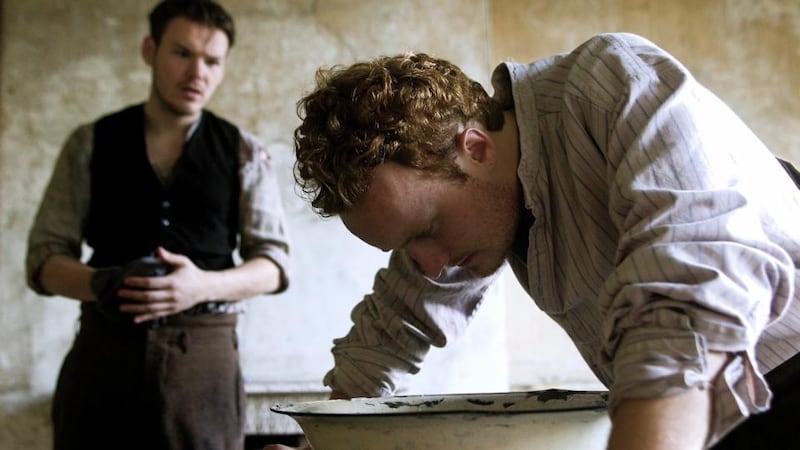Late last week, a sizeable portion of the Irish arts community gathered in a brand new Dublin bar, and tried to keep quiet. This was a surprise party for Róise Goan, who, following five years as director of the Dublin Fringe Festival, will depart at the end of her forthcoming programme.
Most people in attendance, many of whom have emerged as leading artists in their field during her tenure, felt they owed her something. When Goan finally arrived – “surprise!” – she seemed genuinely overwhelmed – so it took a while to realise she had arrived bearing presents for her co-workers. Naive she is not.
Goan was appointed to the role at the age of 27. This was not without precedent: Jimmy Fay was 25 when he founded the Fringe, and delivered its first programme when he was 26; Ali Curran, his immediate successor, was also 26 when she was appointed. When Goan was appointed, Una Carmody was chairwoman of the Fringe. She recently told Goan that one sceptical journalist phoned to ask: "What have you done? Do you have a comment about the child you've just appointed?"


By any reading of the Fringe’s next five years, though, Goan was the right person at the right time. A writer, director and producer who began her professional career just five years earlier, Goan now describes her appointment as “mad – they hired a 27-year-old amateur”. It’s closer to the truth to say that an organisation defined by its sense of adventure gave some young talent a big break. That also sounds like Goan’s defining policy.
If the landscape of Irish arts is distinctly different from even five years ago, the Fringe has helped shape our most imaginative responses to crisis.
Take Louise Lowe and Owen Boss's Anu Productions, the company responsible for the most searing and innovative works of the past decade, which now returns with its latest and biggest production, Thirteen. Or Amy Conroy's Hot for Theatre, which premieres the writer-performer's third play, Break, following the international success of her previous works. Or a Fringe honour roll that includes TheatreClub, the Company, Thisispopbaby, Junk Ensemble, WillFredd Theatre, Ponydance, Making Strange, Talking Shop Ensemble, Rise Productions, PaperDolls and Fishamble's Show in a Bag programme.
Keeping it home-grown
In a time of dwindling resources, Goan did more with less, investing in home-grown talent by introducing developmental initiatives such as Make and Fringe Lab. When one condition of a four-year title sponsorship was to sacrifice a portion of its identity (Absolut Fringe), the programme counterbalanced by drawing more attention to Dublin itself, whether through Fergal McCarthy's buoyant installations Liffey Town and No Man's Land, which directed focus to the artery of the city; Playgroup recasting the capital's streets in German roles for Berlin Love Tour; or Anu bringing audiences wandering through historical secrets, rediscovered and re-inhabited.
'What's new and what's next?'
Every director gets to define "Fringe" according to their own interpretation. "For me, if I can distil it right down," Goan says, "it's always: what's new and what's next?"
This is why some of us will find the programme simultaneously encouraging and unnerving, a cascade of the familiar and the unknown. How out-of-touch will you feel reading up on Xnthony, for instance, when you can’t even pronounce his name? “ ‘Zanthony’ is a performance artist who is interested in the idea of celebrity,” Goan explains. “He’s kind of, like, trashy and fabulous. He’s just recently graduated from NCAD, focused on drag performance art and was a contestant in Alternative Miss Ireland a few years ago.”
Is keeping on top of the new and the next exhausting, I wonder? “Yes,” she says flatly. “This might sound awful, but you have to be ‘on’ all the time. Because your job becomes your life. Everything you see and everything you experience is an indicator for what’s going on.”
That has been expressed by the taglines of various programmes, which tend to merge the faddish with the political: Community (2010), Brave New World (2011), Occupy Your Imagination (2012) and this year (though unadvertised) Citizen Fringe, for which the guiding theme is participation and social action. (That, Goan says, has been her big idea all along.)
Her programming is not led by a fascination with form, she says. (There has long been a misapprehension about whether or not the Fringe accepts plays – it does, but applicants must be in a position to produce them.) Instead, she describes a Fringe aesthetic as “one of truth”; something that might involve artificial methods but addresses real concerns. “Since 2008 and 2009 there has been an inherent optimism – ‘We just have to push through this’ – and, at the same time, the Sisyphean sense of we’re just rolling that rock up the hill. I think the tension between those two things makes for really interesting art.”
Questions about the Fringe's political awareness clearly rankle with Goan. Last year, the Fringe was criticised in The Irish Times' letters page and on RTÉ's Liveline for a perceived lack of engagement with national issues.
However, the programme – from Shaun Dunne's drama of unemployment Death of the Tradesman and Veronica Dyas's sexual confessional In My Bed to the floating monopoly houses of Liffeytown – has never short on the stuff. The recurring styles of performance – playful, confessional, direct-address, interactive, site-specific, or, for lack of a better term, different – may have occluded the view and certainly proved divisive.
"I don't know that it has to be different," Goan replies. "I think that it has to be ahead. It needs to push the art forms forward so that it can push the conversation forward. Something I've been really trying to do over the past few years is to get the work we present into the news pages as well as the arts pages."
Overlooked by officialdom
Goan voices her frustration about the Fringe being overlooked by "officialdom", and she can move quickly from ebullient to embattled: "We've tried to be a little bit more grown-up and organised, not so we can sit at the grown-ups' table, but at least have them notice that we're well-dressed.
“It’s not just about recognition,” she says. “It’s about resources.”
The Fringe, which is still seeking a title sponsor and is heavily dependent on box office income, receives under half the subsidy of the Dublin Theatre Festival. A large amount of its programme, drawn from new and emerging artists, depends on Arts Council Project Awards and FundIt campaigns. "We're really, really struggling," she says. "I don't mean to sound naive or blunt, but to get more money, you have to be perceived to be successful by the powers that be."
There’s a clear tension there, between seeking the independence necessary to recognise “the new and the next” and needing the imprimatur of the establishment. “The Fringe is a house of cards,” Goan says. “It only happens because of goodwill and a nuclear amount of energy and determination. But artists are working for free so much of the time – and we depend on that. Wanting the grown-ups to take notice is about saying ‘it’s not okay that this artist is working for free’. If they had more support they would be better; they would flourish.”
Goan’s tenure has been an illustration of that lesson, and it leaves a pleasing irony: one of the the youngest directors in its history now leaves the Fringe in the most mature state it has known.
The Dublin Fringe Festival runs from
today until September 22, fringefest.com
For full coverage of this year’s festival, see irishtimes.com

















